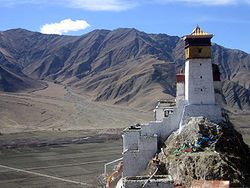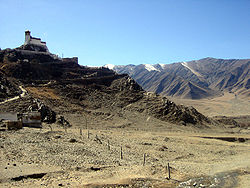
Yungbulakang Palace
Encyclopedia


Yarlung Valley
The Yarlung Valley is formed by the Yarlung River and refers especially to the district where it joins with the Chongye River, and broadens out into a large plain about 2 km wide, before they flow north into the Yarlung Zangbo River or Brahmaputra. It is situated in Nedong County of Lhokha...
, Nêdong
Nêdong County
Nêdong County, is a county of the Shannan Prefecture in the Tibet Autonomous Region....
County in the vicinity of Zêtang the seat of the prefectural administration of Lhoka (Pinyin: Shannan), in the South of Tibet Autonomous Region
Tibet Autonomous Region
The Tibet Autonomous Region , Tibet or Xizang for short, also called the Xizang Autonomous Region is a province-level autonomous region of the People's Republic of China , created in 1965....
of the People's Republic of China
People's Republic of China
China , officially the People's Republic of China , is the most populous country in the world, with over 1.3 billion citizens. Located in East Asia, the country covers approximately 9.6 million square kilometres...
.
According to legend it was the first building in Tibet and the palace of the first Tibetan king, Nyatri Tsenpo
Nyatri Tsenpo
Nyatri Tsenpo was a king of Tibet from the so-called "Yarlung dynasty". His reign is said to have begun in 127 BC. According to traditional Tibetan history, he was the first ruler of the kingdom. He is said to have descended from heaven on Yalashangbo, the sacred mountain...
. Yungbulakang stands on a hill on the eastern bank of the Yarlung River in the Yarlung Valley
Yarlung Valley
The Yarlung Valley is formed by the Yarlung River and refers especially to the district where it joins with the Chongye River, and broadens out into a large plain about 2 km wide, before they flow north into the Yarlung Zangbo River or Brahmaputra. It is situated in Nedong County of Lhokha...
of southeast Naidong County, about 192 km southeast of Lhasa
Lhasa
Lhasa is the administrative capital of the Tibet Autonomous Region in the People's Republic of China and the second most populous city on the Tibetan Plateau, after Xining. At an altitude of , Lhasa is one of the highest cities in the world...
, and 9 km south of Tsetang
Tsetang
Zêtang is one of the largest cities in Tibet and is located in the Yarlung Valley, 183 km southeast of Lhasa in Nedong County of Lhoka Prefecture, Tibet Autonomous Region of China...
.
History
According to a legend of followers of the Bön religion, Yumbulagang was erected in the second century B.C. for the first Tibetan king Nyatri TsenpoNyatri Tsenpo
Nyatri Tsenpo was a king of Tibet from the so-called "Yarlung dynasty". His reign is said to have begun in 127 BC. According to traditional Tibetan history, he was the first ruler of the kingdom. He is said to have descended from heaven on Yalashangbo, the sacred mountain...
, descended from the sky. During the reign of the 28th king, Lha Thothori Nyantsen
Thothori Nyantsen
Lha Thothori Nyantsen was the 28th King of Tibet according to the Tibetan legendary tradition...
, in the fifth century, a golden Stupa
Stupa
A stupa is a mound-like structure containing Buddhist relics, typically the remains of Buddha, used by Buddhists as a place of worship....
, a jewel (and/or a form to the manufacture of dough-Stupas) and a Sutra
Sutra
Sūtra is an aphorism or a collection of such aphorisms in the form of a manual. Literally it means a thread or line that holds things together and is derived from the verbal root siv-, meaning to sew , as does the medical term...
that no one could read fell from the sky on the roof of Yumbulagang; a voice from the sky announced: "in five generations one shall come, that understands its meaning!" Later, Yumbulagang became the summer palace of the 33rd king Songtsen Gampo
Songtsen Gampo
Songtsän Gampo Songtsän Gampo Songtsän Gampo (Tibetan: སྲོང་བཙན་སྒམ་པོ་, Wylie: Srong-btsan sGam-po, 569–649?/605–649? was the founder of the Tibetan Empire (Tibetan: Bod; ), by tradition held to be the thirty-third ruler in his dynasty. In the Chinese records, his name is given as 'Sōngzàngānbù'...
and princess Wencheng
Princess Wencheng
Princess Wencheng was a niece of the powerful Emperor Taizong of China's Tang Dynasty, who left China in 640, according to records, arriving the next year in Tibet to marry the thirty-seven year old Songtsän Gampo the thirty-third king of the Yarlung Dynasty of Tibet, in a marriage of...
. After Songtsen Gampo had transferred his seat to Lhasa
Lhasa
Lhasa is the administrative capital of the Tibet Autonomous Region in the People's Republic of China and the second most populous city on the Tibetan Plateau, after Xining. At an altitude of , Lhasa is one of the highest cities in the world...
, Yumbulagang became a shrine
Shrine
A shrine is a holy or sacred place, which is dedicated to a specific deity, ancestor, hero, martyr, saint, daemon or similar figure of awe and respect, at which they are venerated or worshipped. Shrines often contain idols, relics, or other such objects associated with the figure being venerated....
and under the reign of the 5th Dalai Lama, Ngawang Lobsang Gyatso, a monastery of the Gelugpa school.
The Yumbulagang was heavily damaged and reduced to a single storey during the Cultural revolution
Cultural Revolution
The Great Proletarian Cultural Revolution, commonly known as the Cultural Revolution , was a socio-political movement that took place in the People's Republic of China from 1966 through 1976...
but was reconstructed in 1983.
Interior
The castle is divided into front and back parts. The front is a 3 storey building while the back has a tall tower like a castle. Enshrined at the palace are the statues of Thiesung Sangjie Buddha, King Niechi, the first King of Tibet, Songsten Gampo and other Tubo kings.Zortang
The first cultivated field in Tibet is called Zortang and is located to the northwest below Yungbulagang. Even today farmers sprinkle soil from Zortang on their own fields to ensure a good harvest. There used to be a temple, Lharu Menlha, containing images of the Eight Medicine Buddhas near the field.External links
- Yum bu bla sgang (Tibetan and Himalayan Digital Library)

